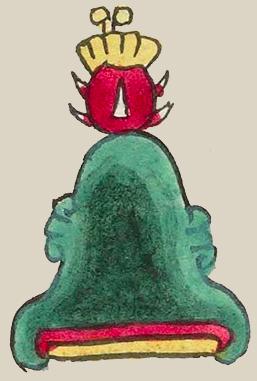Nochco (Mdz38r)
The compound glyph for the place name Nochco consists of a cactus fruit (nochtli) atop a hill or mountain (tepetl), visual but silent, serving as what Whittaker would call a "semantic complement"]. The cactus fruit is primarily red with a yellow and white flower on top and yellow spines or thorns on the sides of the fruit. The hill/mountain is a standard two-tone green bell shape with horizontal red and yellow stripes near the base and curling rocky outcroppings on each slope.
Stephanie Wood
The interpretation of the "coc" part of this place name has troubled various scholars. The verb zo, to bleed, might have been intended to be written as ço, with the tail of the "ç" inadvertently left off. The final locative suffix would be -c, if that were the case. Because the nochtli was considered a metaphor for the heart and its red juice was seen as blood-like, one can imagine that Nochzoc could have been meant ("Where the Cactus Fruit Bleeds"). And, Blanca M. Jiménez P. and Samuel Villela (in Historia y cultura tras el glifo, 1998, p. 101) refer to a place called Nochzoc in Guerrero. But Berdan and Anawalt (Codex Mendoza, 1992, vol. 1, p. 195) are doubtful that the "ç" was written incorrectly. Returning, then, to analyze the name, we discover that Gerardo Gutiérrez (see ch. 33 of the Oxford Handbook of the Aztecs, 2017, p. 476) identifies the modern town of Nuxco, on the coastal plan of Guerrero, as being the Nochcoc (or Nochco) of the Codex Mendoza. Thus, Nochco might have been what was meant, and the double locative suffixes (-co and -c) were the error. If that is the case, then the locative suffix would just have been -co. The mountain or hill may suffix as a semantic locative.
Stephanie Wood
nochcoc. puo
Nochco, pueblo (Nuxco, Guerrero, today)
Stephanie Wood
c. 1541, or by 1553 at the latest
Stephanie Wood
cactus fruits, tunas, Nochcoc

noch(tli), cactus fruit, https://nahuatl.wired-humanities.org/content/nochtli
-co (locative suffix), https://nahuatl.wired-humanities.org/content/co
-c (locative suffix), https://nahuatl.wired-humanities.org/content/c
"At Nochco" (adding that the "at" is redundant, given the double locative suffixes) [Frances Karttunen, unpublished manuscript, used here with her permission.]
"On the Prickly Pear Cactus Fruit" (Berdan and Anawalt, 1992, vol. 1, p. 195)
"En el Tuna"
Stephanie Wood
Codex Mendoza, folio 38 recto, https://digital.bodleian.ox.ac.uk/objects/2fea788e-2aa2-4f08-b6d9-648c00..., image 86 of 188.
The Bodleian Libraries, University of Oxford, hold the original manuscript, the MS. Arch. Selden. A. 1. This image is published here under the UK Creative Commons, “Attribution-NonCommercial-ShareAlike 3.0 License” (CC-BY-NC-SA 3.0).






